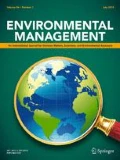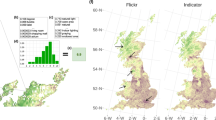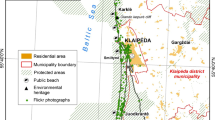Abstract
Nature-based recreation is of increasing economic importance to rural communities transitioning away from traditional natural resource extraction. Rural areas are rich in cultural ecosystem services (CES) that function as essential public goods, providing benefits to livelihoods and fostering conservation of large landscapes. Geotagged photographs from social media platforms capture detailed information on public use of natural areas that can be useful for stakeholders interested in promoting resilient social–ecological systems, but applications of such “big data” are often limited in either spatiotemporal or thematic scope. We integrated multiple aspects of crowdsourced image data to better understand human-environment interactions, focusing on the Northern Forest, a culturally and ecologically significant region of the northeastern United States. Images for the region were mined from Flickr, a crowdsourcing image platform, from 2012 to 2017 and assigned themes via a neural network-cluster analysis pipeline while geographic drivers of nature-based visitor engagement were assessed with random forest models to predict use of CES across the Northern Forest. Daily and seasonal patterns in photography were broadly consistent throughout the region, whereas annual photography trends were more variable. Eleven core themes were identified in images, with 70% of photographs depicting activities related to CES. Visitor engagement with nature was greater near roads and shorelines, and at higher elevations, reflecting tensions between accessibility and aesthetics for recreation. Automated image classification tools can rapidly extract relevant information from crowdsourced photography for exploring human-environment interactions, but researchers should consider multiple spatial and temporal scales in CES assessments of large social-ecological systems.







Similar content being viewed by others
References
Breiman L (2001) Random forests. Mach Learn 45:5–32. https://doi.org/10.1023/A:1010933404324
Chang CC, Cheng GJY, Nghiem TPL, Song XP, Oh RRY, Richards DR, Carrasco LR (2020) Social media, nature, and life satisfaction: global evidence of the biophilia hypothesis. Sci Rep 10:1–8. https://doi.org/10.1038/s41598-020-60902-w
Clarifai (2016) Clarifai Computer Vision, NLP & Machine Learning Platform
Clemente P, Calvache M, Antunes P, Santos R, Cerdeira JO, Martins MJ (2019) Combining social media photographs and species distribution models to map cultural ecosystem services: the case of a Natural Park in Portugal. Ecol Indic 96:59–68. https://doi.org/10.1016/j.ecolind.2018.08.043
Cresswell JW (2009) Research design: Qualitative, quantitative, and mixed methods approaches. 3rd ed. Sage Publications, Los Angeles, CA
Daniel TC, Muhar A, Arnberger A, Aznar O, Boyd JW, Chan KMA, Costanza R, Elmqvist T et al. (2012) Contributions of cultural services to the ecosystem services agenda. Proc Natl Acad Sci USA 109:8812–8819. https://doi.org/10.1073/pnas.1114773109
Eagles PF (2014) Research priorities in park tourism. J Sustain Tour 22:528–549. https://doi.org/10.1080/09669582.2013.785554
Egarter L, Thomas V, Valentina M, Caroline G, Simion H, Stemle E, Tasser E, Depellegrin D (2021) Harnessing artificial intelligence technology and social media data to support Cultural Ecosystem Service assessments. People Nat 3:673–685. https://doi.org/10.1002/pan3.10199
Fisher DM, Wood SA, Young-Hee Roh A, Kim C-K (2019) The geographic spread and preferences of tourists revealed by user-generated information on Jeju Island. South Korea Land 8:1–17.
Fisher DM, Wood SA, White EM, Blahna DJ, Lange S, Weinberg A, Tomco M, and Lia E (2018) Recreational use in dispersed public lands measured using social media data and on-site counts. J Environ Manag 222:465–474. https://doi.org/10.1016/j.jenvman.2018.05.045
Fox N, August T, Mancini F, Parks KE, Eigenbrod F, Bullock JM, Sutter L, and Graham LJ (2020) “photosearcher” package in R: an accessible and reproducible method for harvesting large datasets from Flickr. SoftwareX 12:100624. https://doi.org/10.1016/j.softx.2020.100624
Freelon D (2010) ReCal: Intercoder reliability calculation as a web service. Int J Internet Sci 5:20–33
Gergely KJ, McKerrow A (2013) PAD-US The National Inventory of Protected Areas
Ghermandi A, Sinclair M (2019) Passive crowdsourcing of social media in environmental research: a systematic map. Global Environ Change 55:36–47. https://doi.org/10.1016/j.gloenvcha.2019.02.003
Gössling S (1999) Ecotourism: a means to safeguard biodiversity and ecosystem functions. Ecol Econ 29:303–320. https://doi.org/10.1016/S0921-8009(99)00012-9
Greenwell BM (2017) pdp: an R package for constructing partial dependence plots. R J 9:421–436. https://doi.org/10.32614/rj-2017-016
Hanink DM, White K (1999) Distance effects in the demand for wildland recreational services: the case of national parks in the United States. Environ Plan A 31:477–492. https://doi.org/10.1068/a310477
Hausmann A, Toivonen T, Slotow R, Tenkanen H, Moilanen A, Heikinheimo V, Di Minin E (2018) Social media data can be used to understand tourists’ preferences for nature-based experiences in protected areas. Conserv Lett 11:1–10. https://doi.org/10.1111/conl.12343
Hausmann A, Toivonen T, Heikinheimo V, Tenkanen H (2017) Social media reveal that charismatic species are not the main attractor of ecotourists to sub-Saharan protected areas. Sci Rep. 1–9. https://doi.org/10.1038/s41598-017-00858-6
Heikinheimo V, Di Minin E, Tenkanen H, Hausmann A, Erkkonen J, and Toivonen T (2017) User-generated geographic information for visitor monitoring in a national park: a comparison of social media data and visitor survey. ISPRS Int J Geo-Inform 6. https://doi.org/10.3390/ijgi6030085
Hijmans RJ (2021) raster: geographic data analysis and modeling. Comprehensive R Archive Network (CRAN)
Keeler BL, Wood SA, Polasky S, Kling C, Filstrup CT, Downing JA (2015) Recreational demand for clean water: evidence from geotagged photographs by visitors to lakes. Front Ecol Environ 13:76–81. https://doi.org/10.1890/140124
Koylu C, Zhao C, and Shao W (2019) Deep neural networks and kernel density estimation for detecting human activity patterns from geo-tagged images: a case study of birdwatching on flickr. ISPRS Int J Geo-Inform 8. https://doi.org/10.3390/ijgi8010045.
Kuehn D, Gibbs J, Goldspiel H, Barr B, Sampson A, Moutenot M, Badding J, Stradtman L (2020) Using social media data and park characteristics to understand park visitation. J Park Recr Adm 1–12. https://doi.org/10.18666/jpra-2019-10035
Kuhn M (2008) Building predictive models in R using the caret package. J Stat Softw 28:1–26. https://doi.org/10.18637/JSS.V028.I05
Kursa MB, Rudnicki WR (2010) Feature selection with the boruta package. J Stat Softw 36:1–13. https://doi.org/10.18637/jss.v036.i11
Larson LR, Cooper CB, Stedman RC, Decker DJ, Gagnon RJ (2018) Place-based pathways to proenvironmental behavior: empirical evidence for a conservation–recreation model. Soc Nat Resour 31:871–891. https://doi.org/10.1080/08941920.2018.1447714
Lee H, Seo B, Koellner T, Lautenbach S (2019) Mapping cultural ecosystem services 2.0—potential and shortcomings from unlabeled crowd sourced images. Ecol Indic 96:505–515. https://doi.org/10.1016/j.ecolind.2018.08.035
Levin N, Kark S, Crandall D (2015) Where have all the people gone? Enhancing global conservation using night lights and social media. Ecol Appl 25:2153–2167
Levin N, Lechner AM, Brown G (2017) An evaluation of crowdsourced information for assessing the visitation and perceived importance of protected areas. Appl Geogr 79:115–126. https://doi.org/10.1016/j.apgeog.2016.12.009
Mancini F, Coghill GM, Lusseau D (2018) Using social media to quantify spatial and temporal dynamics of nature-based recreational activities. PLoS ONE 13:1–19. https://doi.org/10.1371/journal.pone.0200565
Mancini F, Coghill GM, Lusseau D (2019) Quantifying wildlife watchers’ preferences to investigate the overlap between recreational and conservation value of natural areas. J Appl Ecol 56:387–397. https://doi.org/10.1111/1365-2664.13274
Medhat M, Dorin A, Dyer A, Burd M, Bukovac Z, Shrestha M (2017) Mapping species distributions with social media geo-tagged images: case studies of bees and flowering plants in Australia Ecological Informatics. Ecol Inform 39:23–31. https://doi.org/10.1016/j.ecoinf.2017.02.006
Neuvonen M, Pouta E, Puustinen J, Sievänen T (2010) Visits to national parks: effects of park characteristics and spatial demand. J Nat Conserv 18:224–229. https://doi.org/10.1016/j.jnc.2009.10.003
Northern Forest Center (2021) The Northern Forest. https://northernforest.org/new-forest-future/the-northern-forest/. Accessed 10 Dec 2021
Oteros-Rozas E, Martín-López B, Fagerholm N, Bieling C, Plieninger T (2018) Using social media photos to explore the relation between cultural ecosystem services and landscape features across five European sites. Ecol Indic 94:74–86. https://doi.org/10.1016/j.ecolind.2017.02.009
QGIS Development Team (2021) QGIS Geographic Information System
R Core Team (2020) R: a language and environment for statistical computing. Vienna, Austria: R Foundation for Statistical Computing
Richards DR, Tunçer B (2018) Using image recognition to automate assessment of cultural ecosystem services from social media photographs. Ecosyst Serv 31:318–325. https://doi.org/10.1016/j.ecoser.2017.09.004
Samani ZR, Guntuku SC, Moghaddam ME, Preoţiuc-Pietro D, Ungar LH (2018) Cross-platform and cross-interaction study of user personality based on images on Twitter and Flickr. PLoS ONE 13:1–19. https://doi.org/10.1371/journal.pone.0198660
Schirpke U, Meisch C, Marsoner T, Tappeiner U (2018) Revealing spatial and temporal patterns of outdoor recreation in the European Alps and their surroundings. Ecosyst Serv 31:336–350. https://doi.org/10.1016/j.ecoser.2017.11.017
Sessions C, Wood SA, Rabotyagov S, Fisher DM (2016) Measuring recreational visitation at U.S. National Parks with crowd-sourced photographs. J Environ Manag 183:703–711. https://doi.org/10.1016/j.jenvman.2016.09.018
Sinclair M, Ghermandi A, Sheela AM (2018) A crowdsourced valuation of recreational ecosystem services using social media data: an application to a tropical wetland in India. Sci Tot Environ 642:356–365. https://doi.org/10.1016/j.scitotenv.2018.06.056
Sonter LJ, Watson KB, Wood SA, Ricketts TH (2016) Spatial and temporal dynamics and value of nature-based recreation, estimated via social media. PLoS One 11:1–16. https://doi.org/10.1371/journal.pone.0162372
Teles da Mota V, Pickering C (2020) Using social media to assess nature-based tourism: Current research and future trends. J Outdoor Recr Tour 30:100295. https://doi.org/10.1016/j.jort.2020.100295.
Tenkanen H, Di Minin E, Heikinheimo V, Hausmann A, Herbst M, Kajala L, Toivonen T (2017) Instagram, Flickr, or Twitter: assessing the usability of social media data for visitor monitoring in protected areas. Sci Rep 7:1–11. https://doi.org/10.1038/s41598-017-18007-4
Toivonen T, Heikinheimo V, Fink C, Hausmann A, Hiippala T, Järv O, Tenkanen H, Di Minin E (2019) Social media data for conservation science: a methodological overview. Biol Conserv 233:298–315. https://doi.org/10.1016/j.biocon.2019.01.023
Van Rossum G, Drake F Jr (2000) Python reference manual
Vaz AS, Moreno-Llorca RA, Gonçalves JF, Vicente JR, Méndez PF, Revilla E, Santamaria L, Bonet-García FJ, et al. (2020) Digital conservation in biosphere reserves: earth observations, social media, and nature’s cultural contributions to people. Conserv Lett. 1–9. https://doi.org/10.1111/conl.12704
Walden-Schreiner C, Leung YF, Tateosian L (2018) Digital footprints: incorporating crowdsourced geographic information for protected area management. Appl Geogr 90:44–54. https://doi.org/10.1016/j.apgeog.2017.11.004
White EM, Bowker JM, Askew AE, Langner LL, Arnold JR English DBK (2016) Federal outdoor recreation trends: effects on economic opportunities. General Technical Report
Wilkins EJ, Wood SA, Smith JW (2020) Uses and limitations of social media to inform visitor use management in parks and protected areas: a systematic review. Environ Manag. https://doi.org/10.1007/s00267-020-01373-7
Winder SG, Lee H, Seo B, Lia EH, Wood SA (2022) An open‐source ima ge classifier for characterizing recreational activities across landscapes. People and Nature 4:1249–1262. https://doi.org/10.1002/pan3.10382
Wood SA, Guerry Ad, Silver JM, Lacayo M (2013) Using social media to quantify nature-based tourism and recreation. Sci Rep 3. https://doi.org/10.1038/srep02976
Wright MN, Ziegler A (2017) Ranger: a fast implementation of random forests for high dimensional data in C++ and R. J Stat Softw 77:1–17. https://doi.org/10.18637/jss.v077.i01
Wunder S (2000) Ecotourism and economic incentives—an empirical approach. Ecol Econ 32:465–479. https://doi.org/10.1016/S0921-8009(99)00119-6
van Zanten BT, Van Berkel DB, Meentemeyer RK, Smith JW, Tieskens KF (2016) Continental-scale quantification of landscape values using social media data. Proc Natl Acad Sci 113:12974–12979. https://doi.org/10.1073/pnas.1614158113
Zaradic PA, Pergams ORW, Kareiva P (2009) The impact of nature experience on willingness to support conservation. PLoS ONE 4:10–14. https://doi.org/10.1371/journal.pone.0007367
Zeiler MD, Fergus R (2013) Visualizing and understanding convolutional networks. Lecture Notes in Computer Science (including subseries Lecture Notes in Artificial Intelligence and Lecture Notes in Bioinformatics) 8689 LNCS. Springer Verlag: 818–833
Zuur A, Ieno EN, Walker N, Saveliev AA, Smith GM (2009) Mixed effects models and extensions in ecology with R. New York, NY: Springer-Verlag
Acknowledgements
We are grateful to James Gibbs for providing important guidance and feedback throughout this project. We thank Alden Sampson and Marshall Moutenot of Upstream Tech for accessing and preparing the image data used in this study, as well as Heera Lee and Bumsuk Seo, for their valuable input on the analysis in this study. We also thank the many students at SUNY ESF who participated in validation exercises. This project was supported by the Northeastern States Research Cooperative, with funding provided by the USDA Forest Service. The conclusions and opinions in this article are those of the authors and not of the NSRC, the Forest Service, or the USDA.
Author information
Authors and Affiliations
Contributions
HG and DK conceived and the designed the study. All authors contributed to data collection, BB and JB performed validation work, and HG and DK led the analysis. The first draft of the manuscript was written by HG and all authors commented on previous versions of the manuscript. All authors read and approved the final manuscript.
Corresponding author
Ethics declarations
Conflict of Interest
The authors declare no competing interests.
Additional information
Publisher’s note Springer Nature remains neutral with regard to jurisdictional claims in published maps and institutional affiliations.
Supplementary Information
Rights and permissions
Springer Nature or its licensor (e.g. a society or other partner) holds exclusive rights to this article under a publishing agreement with the author(s) or other rightsholder(s); author self-archiving of the accepted manuscript version of this article is solely governed by the terms of such publishing agreement and applicable law.
About this article
Cite this article
Goldspiel, H., Barr, B., Badding, J. et al. Snapshots of Nature-Based Recreation Across Rural Landscapes: Insights from Geotagged Photographs in the Northeastern United States. Environmental Management 71, 234–248 (2023). https://doi.org/10.1007/s00267-022-01728-2
Received:
Accepted:
Published:
Issue Date:
DOI: https://doi.org/10.1007/s00267-022-01728-2




